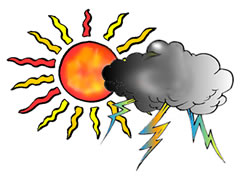Member Area Resources - Risk Management
Severe Weather
 Storms, bushfire, river flooding may directly affect your activities and you need to be prepared to handle them.The Bureau of Meteorology (Weather Bureau) provides warnings about severe weather events.
Storms, bushfire, river flooding may directly affect your activities and you need to be prepared to handle them.The Bureau of Meteorology (Weather Bureau) provides warnings about severe weather events.
WARNINGS
Wind, temperature, humidity and rainfall are weather elements that affect the behaviour of bushfires. In Australia there is a system of assessing these in conjunction with the state of the available fuels to determine a measure of “fire danger” or the difficulty of putting out any fires which may occur.
These warnings are provided when severe weather is expected that is not directly related to severe thunderstorms, tropical cyclones or bushfires. Examples include land gales, squalls, flash-flooding, dangerous surf or tides.
While we experience many thunderstorms, some more intense thunderstorms are referred to as severe thunderstorms. Severe thunderstorms can cause significant localised damage by action of damaging wind gusts, large hail, tornadoes or flash flooding.
Tropical cyclones develop over tropical waters around Australia during the warmer months, mostly November to April. The Bureau provides warning services for these cyclones. Warnings are issued for land-based communities under threat and for mariners.
Guidance Information
A Victorian document, Management of Outdoor Activities for Severe Weather Conditions, includes provides information and commonly agreed procedures for planning and responding to severe weather in the outdoors that involve led activities with dependent participants in Victoria. The nature and intensity of severe weather can vary across Australia and local resources should be consulted in conducting activities in other parts of Australia. It includes considerations for specific events such as:
Bushfire
- Fire Danger Index
- Total Fire Ban (Victoria)
- Fire Danger Rating (FDR)
- Trigger point actions
- Radiant heat
- Heat-related illness
- Signs of fire are observed
- Imminent threat
- In a vehicle
Severe Wind
- Severe Thunderstorm Warning
- Severe Weather Warning
- Gales
- Coastal Waters Wind Warning
- Action
Lightning Strike/ Severe Thunderstorm Warning
- The 30/30 rule
- The 15 second rule
- Lightning position
- In a vehicle
Floods
- Flash flooding
- Riverine flooding
- Action
